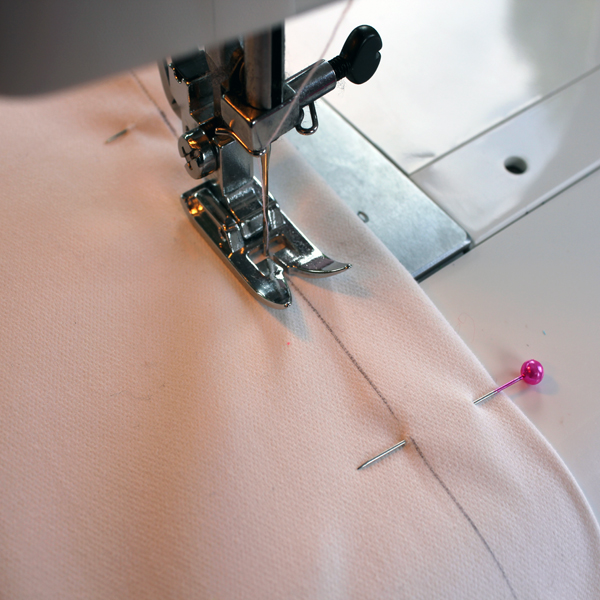Whether you’ve never sewn a stitch in your life or can vaguely remember how to sew from your schooldays, you can be reassured by the fact that sewing is a pretty straightforward task. It’s repetitive, precise and anyone can have a go at it. I’d love for you to have a go at it if you haven’t already tried sewing. Of course, there are always some little tricks and tips that can help you improve skills and do a better job, but as long as you’re moving the thread through the fabric with a needle, a stitch will be formed and you’ll be able to sew. Sewing is really fun and it can save you a tons of money. It can help you to mend items that might otherwise end up in the bin, and the end result is always surprisingly satisfying. And I mean always! Even after years of sewing, I’m still delighted when I finish a task and I’ve actually managed to achieve what I set out to do. So today I thought I’d share 5 tips about sewing with a machine to help get you started:
Sewing is really fun and it can save you a tons of money. It can help you to mend items that might otherwise end up in the bin, and the end result is always surprisingly satisfying. And I mean always! Even after years of sewing, I’m still delighted when I finish a task and I’ve actually managed to achieve what I set out to do. So today I thought I’d share 5 tips about sewing with a machine to help get you started:  1. Choose your tools
1. Choose your tools
Just like any other DIY work, it is necessary to have good tools to do a proper job. Brother and Janome are among the best brands and I would recommend them to all beginners. You can buy a sewing machine for £100 – £150 online. In fact, I have a Janome machine myself which cost less than £100 from John Lewis. I’ve had it for 4 years and it’s really reliable; it’s never let me down yet. However, before you invest in a sewing machine, make sure that this is something you really want because a dusty, unused machine is just going to take up space and make you feel guilty that you’re not using it. Sure, the money might not be too much of an investment for you, but you might also lose interest or run low on time after a couple of months so having the most expensive machine on the market would be a waste of money. 2. Safety first
2. Safety first
You will be likely to work with lots of needles, especially once you get a bit more proficient and start recognizing the differences. This is why you need to learn some valuable basics in sewing machine safety from the start. Group all your equipment in one place so that you can keep an eye on everything. You might lose a needle without even realising and you wouldn’t like to lose a needle on the floor if you have a small child running around, right? It is best if you have a small magnet nearby so it can keep everything in one place. 3. Choice of needles
3. Choice of needles
Newbies can always start with universal sewing machine needle. It’ll be fine for most tasks but as you can assume, the universal needle still has its limitations and specialised counterparts can prove to be much better for specific tasks. Do you really need that denim needle for the projects you’re going to make? If you want to learn more about needles and start using the right ones, here are some tips:
- Light fabrics should be done with a small needle; for example 60-8 or 70-9
- Bigger needles from 100 to 110 is perfect for stronger fabrics
- In order to hem use a twin needle if your sewing machine allows
- Ballpoint needles also have their uses, for example for knitting and stretching
 4. Check which type of thread you’re using
4. Check which type of thread you’re using
Generally speaking, you’ll probably always use the same type of thread. I am talking about cotton thread on a spool and bobbin. The only difference will be in terms of colour and you can even mix-and-match colours by using different colours of the same thread for the bobbin and spool. A problem will only occur if you’re using different types of thread, for example if you mix cotton and polyester thread. This can lead to the thread jamming in the machine and breaking as you sew. In some rare cases when you use embroidery thread, it will only go into the spool.
 5. Sewing in straight line
5. Sewing in straight line
Most new seamstresses have issues with sewing in a straight line. It sounds like the most simple thing to do – sure the machine does it for you, doesn’t it? Even though the stitches might be straight, it’s easy to move the fabric in a different direction and create a wobbly line. The best way to approach this issue is by not looking at the needle. When you concentrate on the needle you won’t noticed any sideways movement. If you focus on the movement of fabric instead you’ll be less likely to make a mistake. Make sure to measure seam allowance distance and create a repositionable seam guide to keep the fabric lined up. If you concentrate on the fabric movement, the machine will sort out the stitches for you.
I hope these 5 tips have helped you if you’re considering starting to sew, or investing in a sewing machine. Once you give it a go, I’m sure you’ll get hooked and want to sew everything you can! I can’t wait to get my machine set up in my new office and have a space dedicated to sewing once again. Watch this space for more sewing tutorials, haha! Please let me know if you have any other tips for beginners by leaving a comment below – thanks 🙂
This article is a sponsored collaboration. The pink links in the content indicate a sponsored link or information source. The blog post reflects my own experience and the sponsor hasn’t had any control over my content 🙂





















3 Responses
Thanks very much Henry! 🙂
amazing tips indeed. i loved your blog & it is good of beginners
You just make 5 tips. But each of the tips is very important for new & expert sewer. Thanks again to discus on safety.